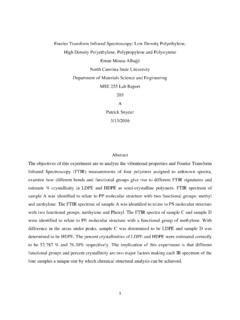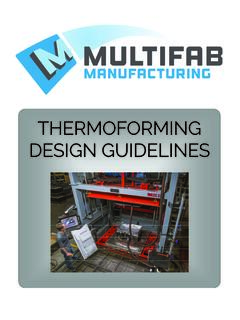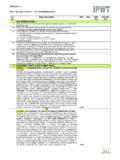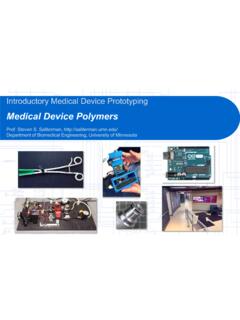Transcription of Polypropylene Processing Guidelines - Asahi Kasei
1 Processing Processing GuidelinesPolypropylene Processing GuidelinesSafetyAsahi Kasei Plastics encourages its customers to review their manufacturing processes to ensure products are being made in accordance with health and environmental safety standards. Material HandlingAs Polypropylene is not hygroscopic, it is unaffected by moisture content. Moisture contents up to do not affect the physical properties of Polypropylene in molded parts, so drying is not typically , high humidity, condensation, or storage conditions that cause excess surface moisture, can affect the visual aesthetics of molded parts. If the resin contains mineral or bio fillers, the likelihood of moisture absorption increases.
2 Drying is only recommended for highly cosmetic applications. If necessary, dry the resin at 75 C (167 F) for two (2) hours in a desiccant dryer. Target Melt TemperaturePolypropylene Melt Temperature RangeNon-Reinforced (Neat)Mineral/TalcGlass Fiber374 - 482 F374 410 F410 437 F446 464 F190 - 250 C190 210 C210 225 C230 240 CTable Processing GuidelinesThe above Guidelines for initial heater band settings are for most injection molded parts. When setting a heat profile, consider residence time, screw RPM and filler type (see Table A).Extruder Speed: Slow, recovery time to 90-95% of required cooling Shot CapacityResidence Time (Minutes)Profile Type<252+Ascending<25<2 Flat25 352+25 35<2 Hump35 452+35 45<2 Reverse> 452+> 45<2 Table BBarrel Heat Recommendations A Flat Heat Profile is generally recommended when developing a molding process with a new resin.
3 When molding a fiber-filled resin, a Reverse Heat Profile is suggested to reduce glass fiber attrition. Since the actual melt temperature is a result of several factors, including barrel size, screw design, RPM, residence time, etc., temperature settings cannot be specified. It is recommended to set the front zone/nozzle temperature to the desired melt temperature. Utilize the barrel heat profile recommendation in Table B as a starting point, then adjust the temperature profile to reach the desired melt temperature. Processing GuidelinesScrew Design GuidelinesFor PP formulations, including those containing short glass fiber and minerals, the suggested compression ratio should range from :1.
4 The recommended compression ratio for long fiber PP should range from :1. PP resins are semi- crystalline and have a specific transition temperature into the melt phase. The desired ramp of the transition zone is recommended to match that of the melt rate of the resin being molded. Verify that the feed, transition and metering zones are designed for semi- crystalline resins. Seek the advice of your screw or machine manufacturer for specific recommendations. Purging GuidelinesRestarting production - If your machine has been left unattended at production settings for more than 30 minutes with resin in the barrel, purge 2x the barrel capacity to ensure all degraded resin is changes Increase barrel temperature to the maximum value in Table A, and purge with unfilled PP/PE followed by purging compound, AsaClean UP.
5 Please reference the AsaClean purging guide for additional use recommendations. Purge in new color and return barrel heats to original down (temporarily) Introduce unfilled PP/PE resin and purge until the barrel is empty. Lower barrel temperatures by 38 C (100 F). Important Note: Please follow your company s procedures for all other Channel DepthTransition LengthCompression RatioMediumMediumMediumTable Processing GuidelinesPerimeter VentingBoss VentingMold TemperaturePolypropylene can be processed over a wide range of mold temperatures; however, for applications where aesthetics are critical, a surface temperature of 80-95 C (176-203 F) is suggested. For thick wall sections or non-cosmetic parts, a surface temperature as low as 20 C (68 F) is preferred in order to reduce cycle pressure controls the rate at which the material enters the mold.
6 Based on the required fill pressure, an additional 10% should be available on high setting. This should be applied for 99% of ram travel during the filling phase to maintain control of fill pressure affects the final part aesthetics. When packing pressure is applied evenly, it controls sink marks and shrinkage. Packing pressure should be applied until the gate freezes off or when consistent part weight is achieved. Back pressure settings are typically set to less than 20% of the injection unit capacity to prevent glass fiber breakage. This normally translates to 500 to 1,000 PPSI (Plastic Pressure per Square Inch). Back pressure settings should be kept as low as possible while maintaining melt uniformity.
7 Fill RateFast fill rates are recommended to ensure uniform melt delivery to the cavity and to prevent premature polymer freezing. Surface appearance, shrink rates, and other defects can be affected by adjusting injection WidthVent DepthVent mm ( in) mm ( in) mm ( in)Clearance at PinClearance at mm ( in) mm ( in) Processing GuidelinesShort Glass Fiber Filled PP Shrinkage AveragesShrinkageGlass Fiber PercentageShrinkage PercentageShort Glass Fiber Filled PP Shrinkage Table LegendParallel to Flow y = + to Flow y = + : Values are based on specimens with 1-3mm wall : The above data represent only the general shrinkage within each percentage of glass fiber incorporated into Polypropylene .
8 Most toolmakers choose the average of linear and transverse values for cutting tools. Use the above values as a guideline, but note that actual shrinkage varies based on wall thickness, fiber orientation (gating), and Processing conditions. Conduct further shrinkage testing to get true shrinkage values before cutting tools. It is advisable to be steel safe when using these data to make tooling decisions. Seek advice from Technical Services, if to flow direction shrink (slope) where Y = average linear shrinkage and X = % of short glass Processing GuidelinesAverage shrinkage values for glass-filled grades of PP in flow and cross flow direction based on Autodesk Moldflow DatabaseThe value for tooling is the average of these two flow directions, and a correction factor by subtracting shrinkage for an isotropic value for tooling.
9 Table of shrinkage calculationsPercent short glass fiberParallel AveragePerpendicular AverageIsotropic AveAverage CorrectionAverage Isotropic for correction factor is in the range of - below the isotropicaverage for part 3d geometry aligns most of the flow paths in the direction of flow, thenisotropic shrinkage would be less, so use ( ) all flow is in perpendicular to part length, then the shrinkage would be higherand correction value lower at ( )Note: The above data represent only the general shrinkage within each percentage of glass fiber incorporated into Polypropylene . Most toolmakers choose the average of linear and transverse values for cutting tools. Use the above values as a guideline, but note that actual shrinkage varies based on wall thickness, fiber orientation (gating), and Processing conditions.
10 Conduct further shrinkage testing to get true shrinkage values before cutting tools. It is advisable to be steel safe when using these data to make tooling decisions. Seek advice from Technical Services, if Processing GuidelinesDisclaimer of Warranty and LiabilityAlthough the information and recommendations set forth herein are presented in good faith and believed to be correct, Asahi Kasei Plastics North America, Inc. disclaims any and all representations and warranties as to the completeness and accuracy thereof. Information is supplied upon the express condition that the persons receiving same will make their own determination as to its suitability for their purposes prior to use.




